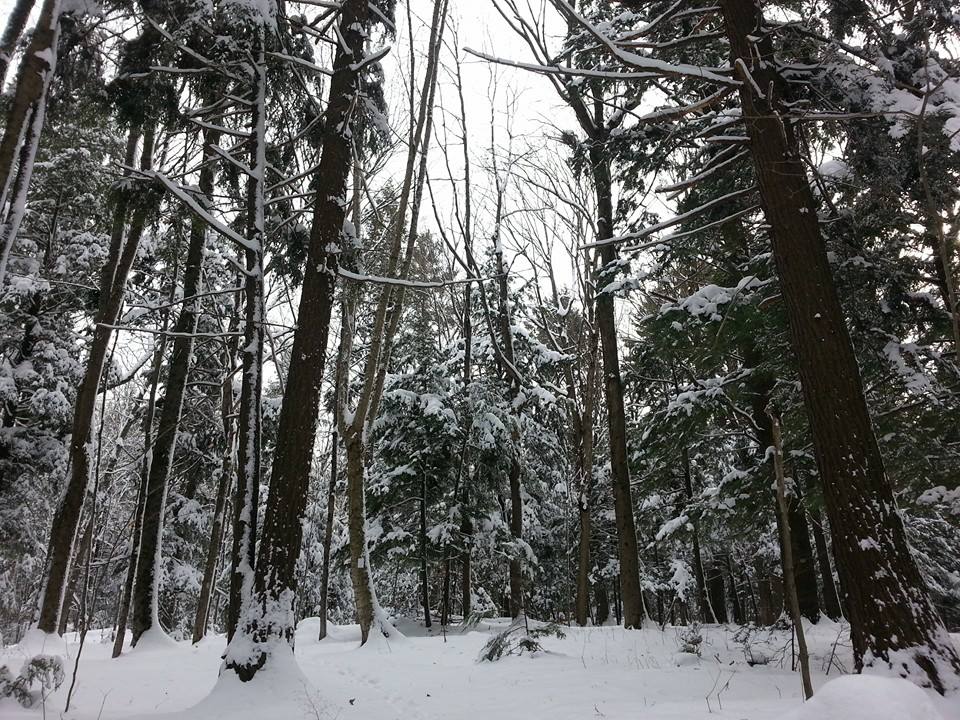Snow provides a unique way of recording the passing-by of various species of wildlife. Their tracks and trails reveal not only what species are hanging around for the winter, but may also reveal some of their behaviours: Are they solitary or travelling as a family? Eating plants or catching prey? Denning in the snow or constantly moving?
In the summer, a particular property may well be a haven for rare and sensitive species such as snapping turtle, western chorus frog, eastern wood-pewee, or a populations of salamanders that breed around the open water on the site. However, less is known about the species that use the site in the winter – what type of small mammal tracks, or impressions of owl wings, might you find in the snow? Wintertime observations help complete the story about year-round animal use.
Snow that is deep and fluffy is a bonus for ruffed grouse, as they can bury themselves in it overnight. By flying head-first into a snowdrift, they use the insulating feature of these interlocked snowflakes to survive a night of bitter cold. And by being hidden from view, they avoid becoming dinner for a great horned owl.
The short-tailed weasel, also called an ermine, uses the deep snow to its advantage. By burrowing unseen through the snow, it can come up close to a sleeping cottontail rabbit or perhaps a grouse that has settled for the night. The ermine further enhances its chance of a successful hunt by having its fur turn colour, from summertime brown to wintertime white.
If you venture into any of these wilderness parcels, be well prepared for a winter outing.
Take a snack and water bottle, and dress in layers that can be easily removed or opened as the exertion of snowshoeing or skiing can quickly raise your body temperature.
Rest often and observe the wildlife around you.
Bird tracks may be too unclear to decipher unless the original snow has melted and hardened and a new coating of light snow has then fallen. If the tracks are placed one foot ahead of the other, it is walking – and, depending on the size of the track, you may have found where a wild turkey, American crow, ruffed grouse, or mourning dove has been wandering by.
If the bird tracks are side by side in a hopping pattern, look nearby for juncos or tree sparrows.
One of the nice things about a walk in a winter woods is you will not be overwhelmed trying identify all of the different birds that may be there in the warmer months. A springtime walk may result in more than 80 bird species, but a winter wander will produce a dozen species on a good day. Look for hairy and downy woodpeckers, black-capped chickadees and, probably, a white-breasted nuthatch or two. Bonus birds could be a red-breasted nuthatch, brown creeper or sharp-shinned hawk.
While several of the birds will migrate, and all the reptiles and amphibians will hibernate, most of the mammals adapt and are out and about. Rabbits and hares are common, fox and coyote tracks will probably be found, and white-tailed deer trails are likely around hemlock trees. Raccoons will be hard to find until the weather stays warm, but porcupines are active all winter. Look for red squirrels in cedar swamps and grey squirrels in hardwood forests.
The Couchiching Conservancy is involved with the management of many properties found throughout Simcoe County. All of the owned properties are open to visitation, but only a few have designated walking trails. If you venture into any of these wilderness parcels, be well prepared for a winter outing. Take a snack and water bottle, and dress in layers that can be easily removed or opened as the exertion of snowshoeing or skiing can quickly raise your body temperature. Rest often and observe the wildlife around you.
Sightings of winter wildlife may be emailed to the Couchiching Conservancy stewardship manager at steward@couchconservancy.ca. Please include the date and location of any sightings.
David Hawke is a staff member with the Couchiching Conservancy.

